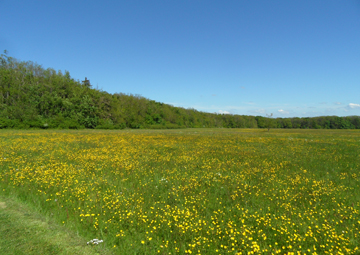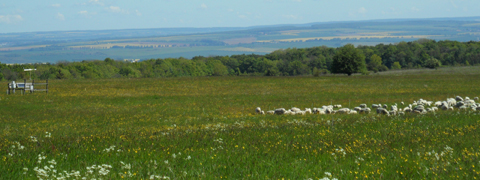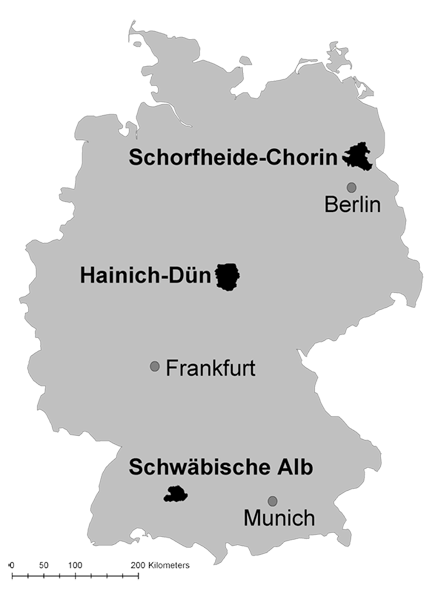Project
STOICHIO
As part of the DFG funded research project Biodiversity Exploratories STOICHIO focusses on the quantitative and qualitative evaluation of nutrients, their regulation within and the transfer between species and their environment (Ecological stoichiometry). This project aims at understanding regulatory mechanisms of stoichiometry from soil to vegetation and whole herbivore communities along a land use gradient.

Extensively used, species-rich meadow close to the National Park Hainich, Thuringia. (photo: Verena Busch) Whereas nutrient cycles in water systems have been looked at extensively, the stoichiometry of nutrients in terrestrial systems have only begun to be analyzed. Until now, most studies have focused on macronutrients such as carbon, nitrogen and phosphorus; but information on micronutrients and trace elements such as Mg, Cl, S, Fe, Co, Ni or Zn, among others, is still very scarce.
Nutritional stoichiometry is element and species specific. Whereas some elements in consumers vary proportionally to their respective source, others are regulated to a constant level or present a certain source-independent variability. Taxa, species and even individuals have different nutrient requirements and are able to regulate their internal nutritional levels according to their needs. Whereas some maintain quite constant levels independent of nutrient availability (stoichiometric homeostasis), others present with a certain plasticity in internal nutrient levels (stoichiometric plasticity) according to availability. However, the regulating processes of nutritional stoichiometry on an individual level up to the community of consumers are still very poorly understood. Changes in nutrient availability in the soil (due to interspecific competition or agricultural management) influence species richness, community composition and grassland productivity. It is not known, nevertheless, whether and how these aspects are affected by interspecific variation in nutritional homeostasis and quantitative requirements of species.
In order to better comprehend species distribution patterns, biodiversity and ecosystem dynamics, it is important to understand the mechanisms behind species’ limitation by nutrients and their regulation. It is hypothesized that the distributional range of plant and herbivore communities along a gradient of resource stoichiometry is constrained or influenced by the level of homeostasis or plasticity of species. It remains to be clarified how this stoichiometric variation contributes to performance and hierarchy of species in communities; and how species respond stoichiometrically to fertilization and change in overall community composition with land use.

Land use in form of sheep grazing on an experimental plot close to the climatic station in the exploratory Hainich-Dün, Thuringia. (photo: Verena Busch) STOICHIO is a joint project of the Working Group of Ecosystem Research at the University of Münster and the Working Group of Ecological Networks at the University of Darmstadt and will closely collaborate with the Biodiversity Exploratories Core Project Botany at the University of Bern and the contributing project ESCAPE at the University of Münster.
Our research aims at answering following questions:- Which nutrients are found in different concentrations in biomass respective to their availability in the soil? Does this variability depend on land-use intensity or phytodiversity?
- Are average nutrient concentrations and levels of homeostasis in selected species modified by land use intensity and nutrient availability in the soil? Do they interrelate with productivity?
- Are species rich grasslands more stable with respect to nutrient composition in biomass or productivity than species poor grasslands?
Project duration and funding
- Project duration: May 2014 - May 2017
- This poject is funded by the German Research Foundation (DFG) as part of the Biodiversity Exploratories

Exploratories
Background: The Biodiversity Exploratories
The Biodiversity Exploratories for Functional Biodiversity Research or Biodiversity Exploratories are a German Science Foundation (DFG) funded research project with more than 30 collaborating research institutions.
Biodiversity and ecosystem research will be merged at a large scale and with a long-term perspective in three different regions in Germany: The Exploratories in the UNESCO Biosphere Reserve Schorfheide-Chorin in Brandenburg, National Park Hainich and surroundings in Thuringia and the UNESCO Biosphere Reserve Schwäbische Alb in Baden-Württemberg.
The multidimensionally oriented project, focusing on an ample network of grassland and forest areas and covering a whole range of management forms and intensities in the three regions, targets to assess the impact of land use on different components of biodiversity. By using a combined approach of georeferenced data collection based on observation, experimentation and modelling, the Exploratories aim at gaining causal insight into interactions and interrelations between land use, biodiversity, ecosystem functioning and processes.
Methods
Methods
In order to assess whether and how the occurrence and performance of species along a gradient of stoichiometric resources is shaped by the individual regulation of stoichiometric homeostasis, field work in all three regions of the Exploratories will be combined with several lab methods.

Harvest and drying of biomass for further processing (photo: Verena Busch) Species distribution patterns and biodiversity will be assessed by vegetation surveys along a land use gradient. Selected species and whole grassland biomass will be sampled in order to assess element specific homeostasis levels and species specific stoichiometric regulation strategies in single species and whole plant communities; which will be related to soil nutrient content and levels of biodiversity. Using the obtained nutrient stoichiometric data, it will be analyzed how nutrients other than N, P and C affect the occurrence of species, species diversity and productivity. Also, we will test whether the nutrient concentration stability in biomass correlates with land use, biodiversity and productivity.
For the biomass analysis of selected species and plant communities as regards to their nutrient content and quality, Near-Infrared-Spectroscopy (NIRS) will be the method of choice. This indirect and non-invasive method is used for the quantification of macronutrients (such as N, P and C) and a few micronutrients (such as Ca, Mg and K) by exploring Infrared spectra in composite samples and has been especially adapted to biomass analysis during the BIOCOMP project.

Processing of the biomass for near-infrared spectroscopy (NIRS) and ICP-spectroscopy (photo: Verena Busch) Micronutrient and trace element quantification in soil and biomass samples will be performed by employing Inductively Coupled Plasma Optical Emission Spectroscopy (ICP-OES), which is used for the analysis of elemental composition and quantification of samples even in minute quantities by evaluating electromagnetic radiation spectra. Also for this purpose, Fluorescence X-Ray Spectroscopy (FXS) will be experimentally applied and adapted for the analysis of biomass samples.
All analyses will be performed in cooperation with the Biodiversity Exploratory Core Project Botany in Bern and with cooperation partners at the University of Darmstadt; the latter of which will look into nutrient stoichiometry of the plant-herbivore system. The assessment of soil nutrients will be performed in cooperation with the Biodiversity Exploratory project ESCAPE (for information on project partners and contact take a look on the right of this page).
Study projects and Theses
Current Theses
Currently there are no theses being worked on in this project. In the past there have been several cooperations with the project Escape, which in the future will offer a number of possibilities of engaging in the Biodiversity-Exploratories, either by writing theses or as helping students.
Of course we can develop a project together (as a Bachelor or Master thesis, or a Study or Research Project) in relation to nutrient stoichiometry of single plant species and entire plant communites, the relation to functional traits and general biodiversity along a land use gradient.
If you are interested in collaborating in the project, also as a student helper, please contact Verena Busch or Till Kleinebecker.
Finished Theses
- Froese, Linda (2017): A long-term study on relationships between land-use intensity, biomass quality and plant diversity in grasslands
- Knabe, Cordula (2017): Impact of seeding and disturbance on plant diversity in agriculturally used grasslands
- Bier, Leonie (2017): Development of floristic diversity in grassland ecosystems
- Heiland, Lukas (2016): Reduced phosphorus ratio homeostasis of grassland plant species declining due to increased land-use intensity
-
Weinauge, Liane (2016): Element concentration of grassland species along a land-use gradient
-
Vogt, Linda (2015): Palatability of Dactylis glomerata along a land-use gradient
STOICHIO
Land-use effects on plant–herbivore stoichiometry: micro- and macronutrients


